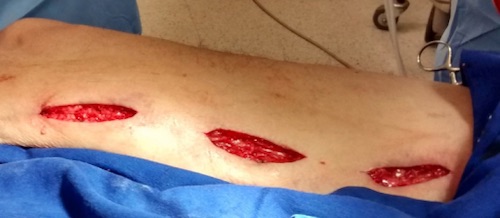Trauma: Peripheral Vascular Trauma
Peripheral Vascular Injury
AAST Peripheral Vascular Injury Scale
- *See AAST
- Injury Scale is Under Copyright
Vascular Injury Signs
- Major/Hard Signs
- Active Arterial Hemorrhage
- Expanding or Pulsatile Hematoma
- Absent Pulse
- Palpable Thrill or Audible Bruit
- Minor/Soft Signs
- History of Significant Arterial Hemorrhage at the Scene
- Nonexpanding Hematoma
- Diminished Pulse
- Proximity to Major Vessels
- Neurologic Deficit
Initial Management
- First Step: Stop the Bleed (Manual Pressure or Tourniquet)
- Major/Hard Signs: Surgical Exploration
- Minor/Soft Signs: Imaging (ABI #1; Then CTA If ABI < 0.9)
Operative Sequence
- Temporary Bleeding Control
- Options:
- Manual Pressure
- Balloon Catheter Inserted into the Wound if Deep & Narrow
- Tourniquet
- Options:
- Extensive Exposure
- Definitive Control
- Decision (Repair vs Damage Control)
- Bony Stabilization Before Vascular Reconstruction
- If Extremity is Grossly Ischemic or Actively Hemorrhaging – Control with a Temporary Shunt & Fasciotomy Prior to Bony Stabilization & Then Vascular Reconstruction
Arterial Exposure
Arterial Injury Management
- Partial Injury:
- < 50% Circumference: Arteriorrhaphy
- Small Transverse Wound are Often Amenable to Primary Repair
- Longitudinal or More Complex Injury Often Requires Patch Angioplasty
- Primary Repair Risks Stricture/Occlusion
- Can Use Autologous Vein or Synthetic Patch
- ≥ 50% Circumference: Resect & Treat as a Complete Transection
- *Consider Lateral GSV Patch Angioplasty for Longitudinal Elliptical Defects 50-75%
- Avoid Reducing Diameter > 50% – Risk Hemodynamically Significant Occlusion
- < 50% Circumference: Arteriorrhaphy
- Complete Transection:
- Short-Segment (< 2 cm): Debridement & End-to-End Anastomosis
- Long-Segment (> 2 cm): Bypass/Interposition Graft
- Preferred Graft: Contralateral Saphenous Vein
- Other Options: Ipsilateral Saphenous Vein or PTFE
- Consider Addition of Proximal & Distal Thrombectomy
- Damage Control: Temporary Shunt vs Ligation
Temporary Vascular Shunts
- Types:
- Commercially Available
- Improvised Shunts:
- Chest Tubes
- IV Tubing
- Feeding Tubes
- Diameter:
- Diameter Should Be Chosen to Match Corresponding Vessel
- Largest Possible Without Forcing
- Length:
- Commercially Available Shunts Should Generally Not Be Trimmed – Smooth Edges Avoid Intimal Damage
- Improvised Shunts Should Allow 2 cm Overlap on Each Side
- Removal:
- Maximum Length of Time Able to Leave in Situ is Unknown
- Perform Definitive Repair as Soon as Feasibly Safe
- Most Remain Patent for 24-48 Hours
Traumatic Arteriovenous (AV) Fistula
- Sx: Palpable Thrill & High-Output Cardiac Failure
- Branham Sign: HR Drop 10 bpm When Occluded

Combat Application Tourniquet (CAT) 1

Incisions for GSV Harvest 2
Peripheral Venous Injury
Definition
- Proximal:
- IVC to Popliteal Veins
- SVC to Axillary Veins
- Distal: Distal to Popliteal or Axillary Vein
Management of Proximal Injury
- Surgical Repair vs Ligation
- No Segmental Loss:
- Lateral Venorrhaphy
- End-to-End Anastomosis
- Patch Venoplasty
- Segmental Loss:
- Interposition Graft (Autologous Vein vs Prosthetic Conduit)
- Ligation
- Additional Considerations with Ligation:
- Judicious Use of Fasciotomy
- Limb Elevation
- Limb Compression
- Monitoring for DVT (Consider Prophylactic Long-Term Anticoagulation)
Management of Distal Injury
- General Management is Nonoperative
- Ligation if Found Intraoperatively
References
- Indnam. Wikimedia Commons. (License: CC BY-SA-3.0)
- Gontijo de Deus K, Diogo Filho A, Cesar Santos P. A randomised controlled trial of mini incision or conventional incision for saphenous vein harvesting in patients undergoing myocardial revascularization. Ann Med Surg (Lond). 2016 Feb 17;7:1-6. (License: CC BY-NC-ND-4.0)